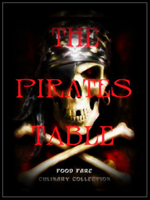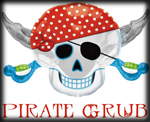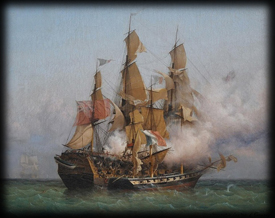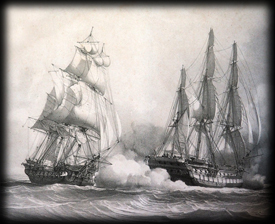![]()
As long as the high seas were travelled for commerce purposes, piracy has existed in one form or another. In truth, pirates have a sullied and violent history. In encyclopedic terms, "piracy" is an act of robbery or criminal violence at sea. The word "pirate" is actually taken from the Latin term pirata and Greek peirates. It is also similar to peril.
Pirate crews were usually formed from petty thieves and renegades; in essence, men already on the wrong side of the law. When not at sea, pirates withdrew to safely isolated inlets, where they drank heartily and amused themselves by gambling and frolicking with women.
The Golden Age of Piracy is accepted by historians to span between the 1650s to the 1730s. The time frame covers three periods of strong activity, including the Buccaneering Period (1650-1680), Pirate Round (1690s) and the Post-Spanish Succession (1716-1726).
The earliest mention of pirates was recorded in the 14th-century BC, when "sea peoples" or "sea thieves" threatened the Aegean and Mediterranean. They were also known to kidnap young boys and girls to be sold into slavery.
Piracy was particularly rampant between the 16th and 19th-centuries throughout Europe and the Caribbean. Asia also had their fair share of sea-faring renegades. Wokou (Japanese) and Zheng Yi (1765–1807) were among the most well-known. In Europe, Zaporizhian Sich (Cossacks) plundered settlements in the Ottoman Empire and Crimean Khanate from the 16th through 18th centuries.
The Viking claim to piracy fame came mainly between the 8th and 12th centuries, when Scandinavian buccaneers raided Italy, North Africa and coasts of the Baltic Sea, also going as far as the Black Sea and Persia. Moors also got into the game, establishing footholds in France, Italy and the Balearic Islands.
Slavic Narentines lurked in the Adriatic Sea during the 7th century, when they plundered southern Italy. The Vitalian Brotherhood was a well-known company of pirates in the 14th century, hired by the Duke of Mecklenburg to battle against Denmark.
In 1241, English-born William Maurice was the first person known to be executed for piracy. Medieval Europe also produced Frisian pirates. Pier Gerlofs Donia and Wijerd Jelckama fought against Roman Emperor Charles V, which earned them iconic status.
(Pictured above and below): Fight between the French Confiance (led by French privateer Robert Surcouf) and the Kent (captained by Robert Rivington) in Calcutta (Kolkata) on 7th October 1800, which resulted in the capture of the Kent. Portrait by Ambroise Louis Garneray (1783–1857). Click on images to view larger sizes in a new window.
In October 1800, a fight between the French Confiance (led by French privateer Robert Surcouf) and the Kent (captained by Robert Rivington) took place near Calcutta (now known as Kolkata). The Confiance was equipped with 437 men, 300 of which were sailors and soldiers. Surcouf overtook his opponent after a battle of nearly two hours. At the end of the day, 14 from the Kent were killed (including Rivington), while the French suffered only five losses. The capture of the Kent was a sensation at the time it occurred, compounded when the British Admiralty promised a hefty reward for anyone who could capture Surcouf.
The Barbary Corsairs operated from Tunis, Tripoli and Algiers - an area also known as the Barbary Coast - during the 16th to 19th centuries. While they primarily trolled the western Mediterranean, their reach also extended to West Africa's Atlantic seaboard, South America and the North Atlantic to Iceland. Along with seizing ships, the Barbary Corsairs raided coastal towns in France, Italy, the Netherlands, Portugal, Spain and the British Isles. The main objective of the raids was to capture slaves for Islamic markets in the Middle East and North Africa.
As late as the 1870s, pirates who sailed Caribbean waters often targeted areas of the United States Eastern Seaboard. Blackbeard (Edward Teach) focused on the South, particularly South Carolina. River piracy also sprung to life during the 18th and 19th centuries, with most attacks centered along the Mississippi and Ohio River valleys. Stack Island in Mississippi became a stronghold for river pirates at various times, including Little Harpe and Samuel Mason. Another pirate lair was located in Cave-In-Rock, Illinois, which also provided a safe haven for well-known bandits, counterfeiters, highwaymen, serial killers and other outlaws.
![]() BUCCANEERS, PIRATES & PRIVATEERS
BUCCANEERS, PIRATES & PRIVATEERS
What are the differences between buccaneers, pirates and privateers? The main aim of pirates was to criminally plunder and pillage, while privateers were often conducting business under letters of marque and reprisal (lettre de marquee) from their respective governments. "Buccaneers" was the term originally given to pirates who mainly attacked Spanish shipping fleets in the Caribbean Sea during the 17th century. Crews on buccaneer ships also tended to be larger, and were more likely to attack coastal areas. Later, buccaneer became the general synonym used for pirates as well.
![]() MODERN DAY PIRACY
MODERN DAY PIRACY
Sea piracy in the modern age is still a great concern for many coastal nations, especially in areas of the Indian Ocean, Red Sea, off the Somali coast, Singapore and the Strait of Malacca. The modern definition of piracy includes several criteria: boarding, extortion, hostage-taking, kidnap for ransom, murder, robbery, sabotage, seizure and shipwrecking. Nowadays, pirates also make use of available technology such as cell phones, GPS, social media and sonar systems.




